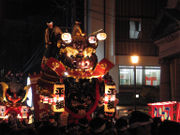
Karatsu Kunchi
Encyclopedia

Karatsu, Saga
is a city located in Saga Prefecture on the island of Kyūshū, Japan. Its name, formed from the Japanese word roots 唐 kara , and 津 tsu , signifies its historical importance as an ancient trading port between Japan with China and Korea...
, Saga Prefecture
Saga Prefecture
is located in the northwest part of the island of Kyūshū, Japan. It touches both the Sea of Japan and the Ariake Sea. The western part of the prefecture is a region famous for producing ceramics and porcelain, particularly the towns of Karatsu, Imari, and Arita...
, on Japan
Japan
Japan is an island nation in East Asia. Located in the Pacific Ocean, it lies to the east of the Sea of Japan, China, North Korea, South Korea and Russia, stretching from the Sea of Okhotsk in the north to the East China Sea and Taiwan in the south...
's island of Kyūshū
Kyushu
is the third largest island of Japan and most southwesterly of its four main islands. Its alternate ancient names include , , and . The historical regional name is referred to Kyushu and its surrounding islands....
.
About
The festival, which begins on the evening of November 2 and concludes on the 4th, features daily parades of fourteen hikiyama, massive floats in the form of samuraiSamurai
is the term for the military nobility of pre-industrial Japan. According to translator William Scott Wilson: "In Chinese, the character 侍 was originally a verb meaning to wait upon or accompany a person in the upper ranks of society, and this is also true of the original term in Japanese, saburau...
helmets, sea bream, dragon
Dragon
A dragon is a legendary creature, typically with serpentine or reptilian traits, that feature in the myths of many cultures. There are two distinct cultural traditions of dragons: the European dragon, derived from European folk traditions and ultimately related to Greek and Middle Eastern...
s, and other fantastical creatures, all constructed from wood, lacquer, and other materials. It is the major event of the Karatsu calendar, regularly drawing crowds of anywhere between 150,000 to 500,000 people from the surrounding area over the course of the three day holiday.

Ton
The ton is a unit of measure. It has a long history and has acquired a number of meanings and uses over the years. It is used principally as a unit of weight, and as a unit of volume. It can also be used as a measure of energy, for truck classification, or as a colloquial term.It is derived from...
s — is drawn through the streets of the city by teams of bearers selected from families living in the fourteen traditional neighborhoods of Karatsu, to the chant of "En-ya! En-ya! En-ya!"(or"Yoi-sa! Yoi-sa! Yoi-sa!") and the music of taiko
Taiko
means "drum" in Japanese . Outside Japan, the word is often used to refer to any of the various Japanese drums and to the relatively recent art-form of ensemble taiko drumming...
drummers and flutists perched on the floats' base. The event, which is coordinated by the local Shinto shrine
Jinja (Shinto)
A Shinto shrine is a structure whose main purpose is to house one or more Shinto kami....
(near which the floats are stored during the rest of the year), has been held for several centuries now; the current incarnations of the floats were constructed between 1819 and 1876. In 1980, the festival was designated an "Important Intangible Folk Cultural Property".
List of hikiyama
-
- 1 red lion (赤[獅子) Katana-machi( 1819)
- 2 blue(green) lion (中町の青獅子) Naka-machi(1824)
- 3 Turtle and fisherman Urashima TaroUrashima Tarois a Japanese legend about a fisherman who rescues a turtle and is rewarded for this with a visit to Ryūgū-jō, the palace of Ryūjin, the Dragon God, under the sea...
(カメと浦島太郎) Zaimoku-machi(1841)
- ※It was not Urashima TaroUrashima Tarois a Japanese legend about a fisherman who rescues a turtle and is rewarded for this with a visit to Ryūgū-jō, the palace of Ryūjin, the Dragon God, under the sea...
but a Gemstone on the Turtle when it was first build.
- 4 Helmet of Samurai Miyamoto Yoshitsune (源義経の兜) Gofuku-mach(1844)
- 5 sea bream (鯛) Uoya-machi(1845)
- 6 phoenix-shaped ship (鳳凰丸) Oishi-machi(1846)
- 7 flying dragon (飛龍) Shin-machi(1846)
- 8 golden lion (金獅子)Hom-machi(1847)
- 9 Helmet of Samurai Takeda Shingen (武田信玄の兜) Kiwata-machi(1864)
- 10 Helmet of Samurai Uesugi Kenshin (上杉謙信の兜) Hirano-machi(1869)
- 11 drunken monster ogre and the helmet of Samurai Minamoto Yorimitsu (酒呑童子と源頼光の兜)(1869)
- 12 lion grabbing a ball (珠取獅子) Kyo-machi(1875)
- 13 tiger-headed orca (鯱) Kako-machi(1876)
- 14 dragon-headed ship (七宝丸) Egawa-machi(1876)
- disappear :black lion(黒獅子) Konya-machi

